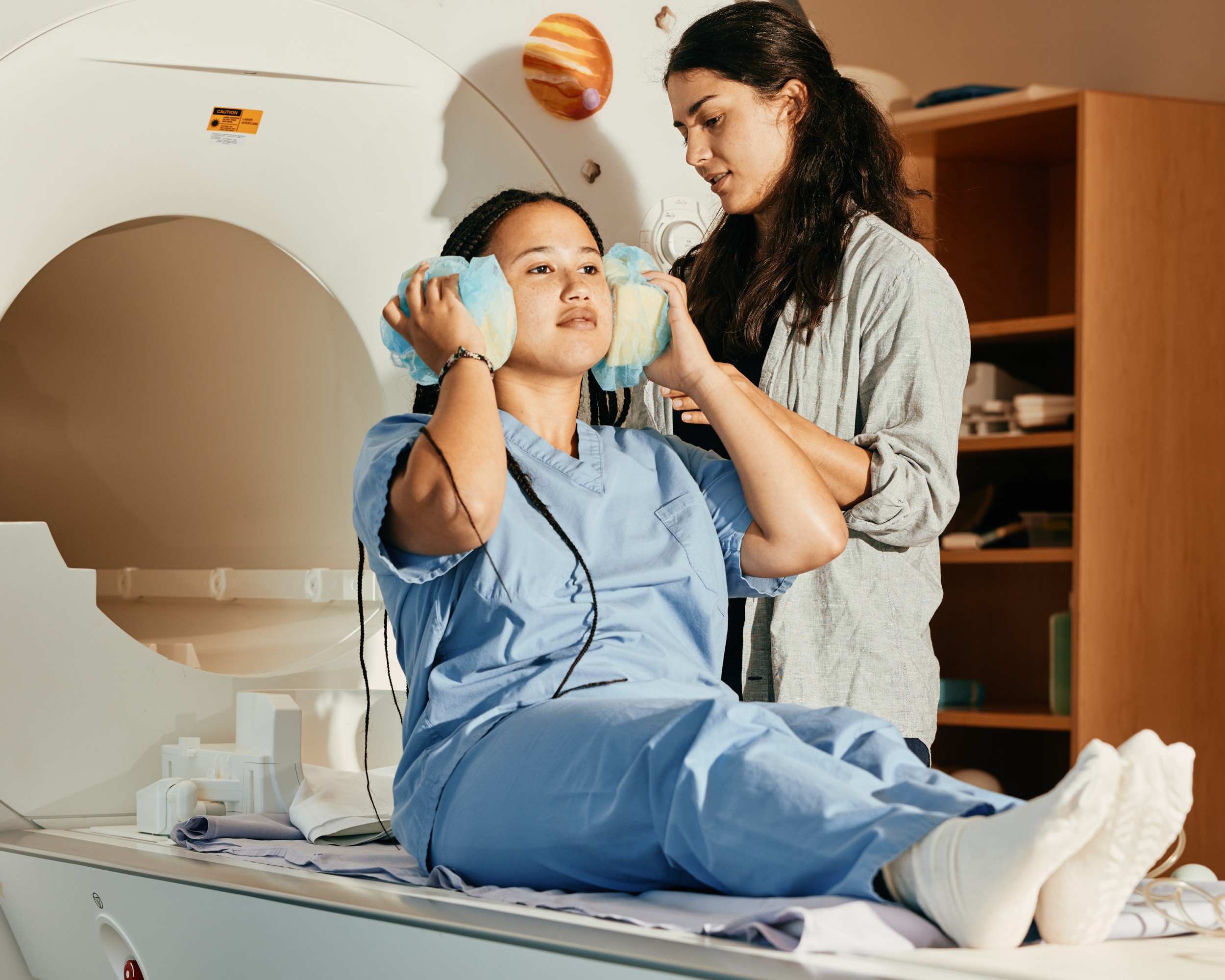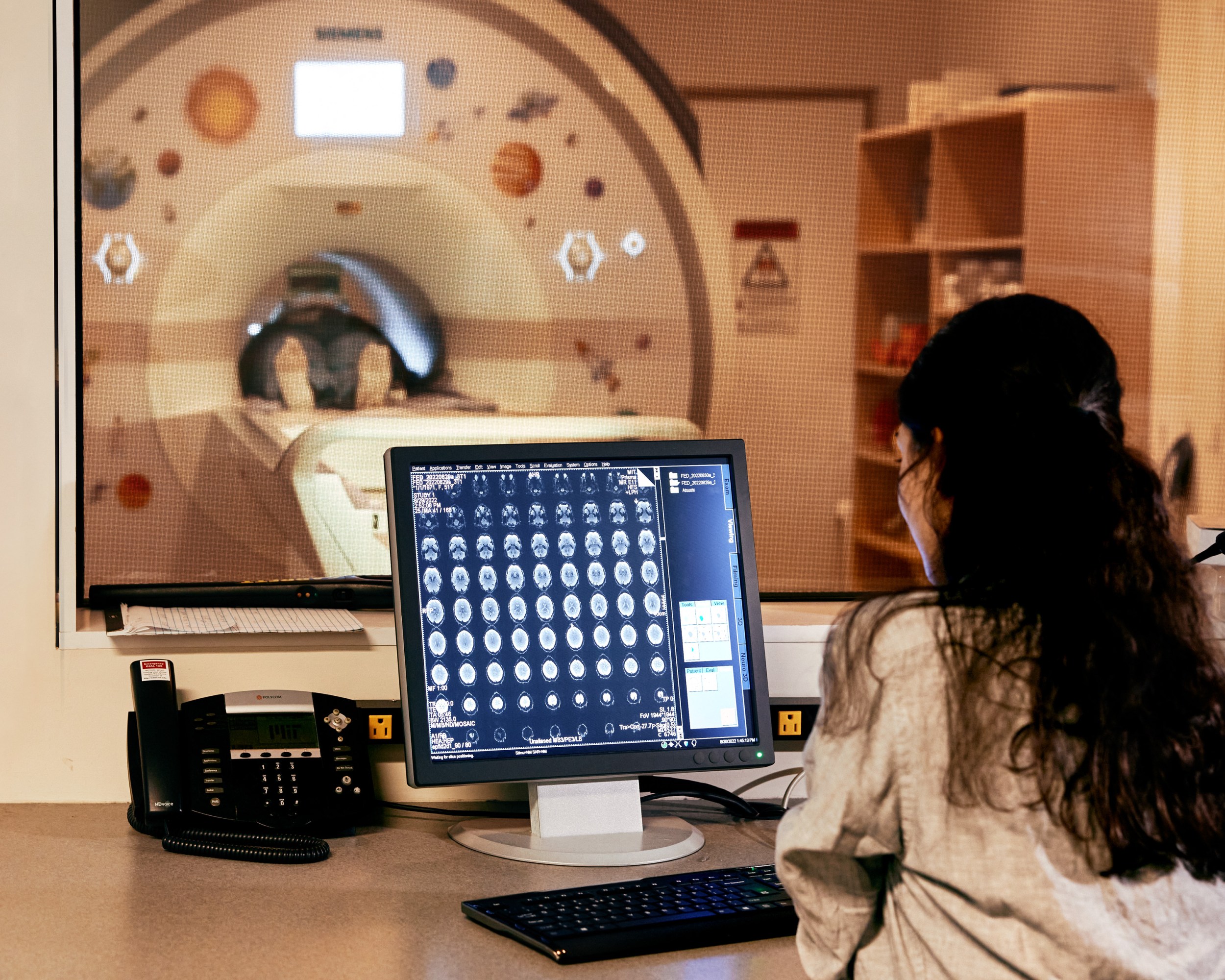https://www.technologyreview.com/2022/10/25/1060386/the-bilingual-brain/
Close your eyes and, for a moment, imagine you know two languages. For any noun you can think of—object, feeling, place—two words exist where a monolingual brain comes up with only one. When speaking, reading, or writing, your brain must decide which of those words to use—an added task on top of the language processing you’re already doing.
Scientists suspect that sorting through those extra words—and switching between them—gives bilingual people more practice with cognitive control. But whether bilingual brains are neurologically different from monolingual ones is still unknown.
Saima Malik-Moraleda, a fifth-year PhD student in the Harvard/MIT Program in Speech and Hearing Bioscience and Technology, is trying to help answer this question. In the process, she hopes to uncover ways to ease some of the cultural and political tensions that surround bilingualism, especially in cultures where certain languages carry distinct political connotations. As a member of the McGovern Institute lab of Ev Fedorenko, PhD ’07, who researches how brains create language, Malik-Moraleda is studying bilingual brains in a new way.
Neurobiologists typically focus on the relative involvement of different brain regions in bilingual activity. Malik-Moraleda is taking that one step further by studying neural networks—the specific pathways by which information travels in the brain. Instead of simply observing which brain regions light up during a particular activity, she uses what’s known as a localized approach, tracking the reactions of specific sets of neurons within—or sometimes between—those regions.
Malik-Moraleda herself speaks Spanish, Kashmiri, Catalán, English, Urdu, Hindi, and French, and she is learning Arabic. She has always been cognizant of the cultural questions that bilingualism presents. Her mother is from Spain and her father is from Kashmir, a disputed region of South Asia that is claimed by both India and Pakistan. Growing up, she would spend the school year in Girona, a city in Spain’s Catalonia region, and travel with her father to Kashmir during summer breaks.
Splitting her year between the two places revealed to Malik-Moraleda how differently they treated bilingualism. Both regions are culturally different from surrounding areas and have historically fought for independence, so residents often speak a region-specific language as well as the primary language of the surrounding country (or countries). On street signs in Barcelona, for instance, “you’re going to see Catalán first, then Spanish, and then English,” Malik-Moraleda says. But while Catalonians prefer Catalán and tend to speak Spanish only when necessary, in Kashmir, she says, parents generally discourage their children from even learning Kashmiri. Instead, they urge them to speak the more commonly used languages of Urdu or English to better prepare them for schooling and a career.
As a polyglot child, watching her relatives neglect Kashmiri bothered Malik-Moraleda. More than sadness or anger, she felt confusion—why, when given the chance, would someone not seize the opportunity to speak two languages? “It always blew my mind,” she says. She decided to pursue a career uncovering how bilingual brains actually work so she could show her community that bilingualism might have some valuable advantages too.


Saima Malik-Moraleda prepares a lab colleague for an MRI imaging session and reviews brain images. Typically, she scans people as they listen to their native language and any other languages they speak.
She began in high school, writing a senior project about bilingual brains. Then she majored in psychology at the Autonomous University of Barcelona and spent her junior year at the University of California, San Diego. While in San Diego, she attended a talk by MIT professor of brain and cognitive sciences Nancy Kanwisher ’80, PhD ’86, who mentioned the work of Fedorenko, a close collaborator and the Middleton Career Development Associate Professor of Neuroscience at MIT.
Malik-Moraleda was living in New Delhi after college when she learned of the “Alice” project, a new effort led by Fedorenko. The study, which has participants listen to translations of passages from Alice in Wonderland while in an MRI machine, aims to map the neural networks used for language processing in speakers of as many world languages as possible.
Because Malik-Moraleda had access to speakers of languages like Hindi, Telugu, and Tamil in New Delhi, she emailed Fedorenko, offering to help. To her surprise, Fedorenko responded within a day, and offered her coauthorship. “It was crazy,” she says. “That’s what led me to be like, ‘Yes, I really want to work with this person.’”
Malik-Moraleda’s work since she arrived at MIT—where she is also advised by professor of brain and cognitive sciences Ted Gibson—has formed the basis of a 2021 study with Fedorenko looking at executive function in bilingual people. Previous studies had yielded conflicting results about whether bilingualism is linked to superior executive function, in part because bilingual people often learn different languages at different ages and speak at different levels of proficiency.
For their study, Malik-Moraleda and Fedorenko used data that the lab had collected by scanning people’s brains while they completed a task related to spatial working memory: remembering where a sequence of light flashes had appeared on a grid. They identified 55 bilingual and 54 monolingual subjects who were otherwise similar, and controlled for different kinds of bilingualism by including only bilingual people who had learned their second language before age six and reported a proficiency score of 4 or 5 on a scale of 1 to 5.
Previous studies had been anatomy-based, looking at brain activity in specific regions associated with executive function tasks, such as the left frontal cortex. But the left frontal cortex is associated with many networks, including both the domain-general multiple-demand (MD) network, which supports executive function, and the language-selective network, which does not. Malik-Moraleda and Fedorenko suspected that the anatomy-based studies produced conflicting results because they didn’t attempt to identify which network was being activated.
What’s more, the exact boundaries of the MD network can differ from one person to the next, and it only partially involves the left frontal cortex. So instead of simply looking for activity in that brain region, they took the localized approach and looked specifically at the MD network. They found that bilingual people consistently showed stronger neural responses in that network than monolingual people did when performing the flashing-light task—and they performed better.
Malik-Moraleda hadn’t expected the 2021 paper—which she thinks was the first to use the localized approach to study bilingual brains—to corroborate anatomy-based studies that had showed stronger executive function responses in bilingual brains. She’d thought it might show that there was no difference.
But while the results are exciting, Malik-Moraleda says there could be other explanations for the increased activity in the MD network. For example, a lot of bilingual people are immigrants, or children of immigrants, who have had to deal with more challenges in their lives. “More motivation and grit,” she says, could also be linked to higher executive functioning.
Under the umbrella of the Alice project, Malik-Moraleda has contributed to other high-impact language research, including a 2022 paper in Nature Neuroscience outlining the discovery of similarities in brain processing among speakers of diverse world languages. The team (on which she served as lead author with Dima Ayyash ’12, MCP ’13) reported that the language network of the brain responds similarly across 45 languages.
“It does seem like the language network in the brain is evolved to support all the languages in the world,” says Malik-Moraleda.
One purpose of the research was to make it easier to study how language works in general—not just for English speakers, who have been the subjects of most studies to date. Other languages don’t share all of English’s features, such as its conventions for word order. Establishing the properties of the language network over 45 different languages, though, lays the groundwork for future studies of linguistic elements that might be difficult to study in English speakers.
The researchers published all their fMRI data as well as recordings and other materials used in the study, and she hopes other neurobiologists will use them to improve methods of studying language and expand the number studied. “It’s an invitation for researchers who are in an area [where people] speak a language that is not usually researched to use those tools as well,” she says.
“Her work helps build a diverse and inclusive language research community,” says Fedorenko, who calls Malik-Moraleda a fearless researcher and a wonderful colleague.
After finishing her PhD, Malik-Moraleda plans to use her research to tackle social and political problems. While she has realized that the science behind language processing is much more complex than she originally imagined, she hopes that revealing the features of the bilingual brain will help convince people like her relatives in Kashmir that speaking multiple languages is a gift.
Malik-Moraleda would also like to examine whether some languages might be more conducive to cult-building because of how they are structured. And she wants to study how the brain’s response to constructed languages—like Klingon from Star Trek or Dothraki from Game of Thrones—differs from its response to natural languages. More than anything, though, she’s committed to keeping in mind the need to study diverse languages, which she says will give researchers a more holistic understanding of language processing.
“We have to look at as many languages as possible,” she says, “for us to be able to understand language processing in its entirety.”
via Technology Review Feed – Tech Review Top Stories https://ift.tt/ekmtC3J
October 25, 2022 at 05:30PM
